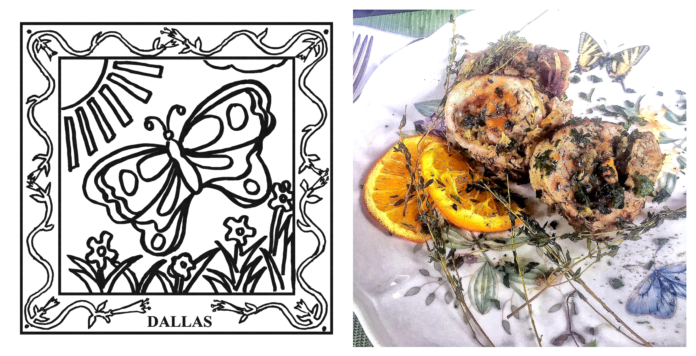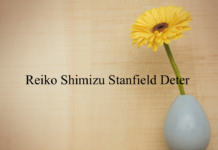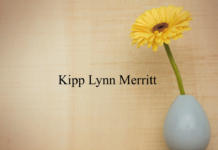
The Cullman Tribune is celebrating the Alabama Bicentennial (1819-2019) with statewide field reporting by Alabama Master Gardener/Botanical Artist Ben Johnson South. This year-long feature, “The 67-County Alabama Garden Party,” will spotlight different counties each week. Each county will get its own “quilt block,” along with a historical profile, and we’ll share a recipe specific to the area. At the end of the year, all 67 counties will be put in a book to commemorate the Bicentennial.
Dallas County
What’s the first thing that comes to mind when you think of Selma? You’re right, Selma is “THE BUTTERFLY CAPITAL OF ALABAMA.”
Alabama has more than 150 species of butterflies. Our “state within a garden” offers nurturing habitats for butterflies to be sheltered from the weather, to feed, to multiply and to delight. In Dallas County, you’ll find acres of colorful butterflies including swallowtails, sulphurs and satyrs. In 1989, the Alabama Legislature adopted the gloriously striped, proudly wide-winged Eastern Tiger Swallowtail as the state’s official butterfly. There are meadows of nectar-kissed milkweed beckoning throngs of those graceful beauties here.
The monarchs returned to meet a King in Dallas County on March 21, 1965. This was the day Dr. Martin Luther King, Jr. led 3,200 freedom-loving, nonviolent protestors from Selma on a 54-mile, three-day march which swelled to a crowd of 25,000 supporters in Montgomery. Ultimately, the winds that carry the butterflies in this part of Alabama led to the freedom of the Voting Rights Act, which became law on Aug. 6, 1965.
“You’re a butterfly and butterflies are free to fly” is a lyric from an Elton John song. Selma and Dallas County are known throughout the world for championing freedom for all. Butterflies are a beautiful, age-old symbol of the fragile right of freedom we cherish and the determination to soar. Butterfly fossils date to the Paleocene Age 56 million years ago.
Monarch butterflies, like the ones that lifted the spirits of the freedom-marchers in Selma, occur in every county of Alabama. We mostly see them in our state during the spring when thousands of nomadic monarchs traverse north as far as Canada after wintering in the warm cliffsides of Mexico and then again in the fall when they are returning to their winter havens.
Dallas County is an ideal place on our “Alabama Garden Party” tour to learn simple things any of us can do to attract and nurture butterflies.
THE DALLAS COUNTY 6-STEP PLAN TO CREATE A BUTTERFLY GARDEN:
- SELECT A SUNNY SPOT- Butterflies are cold-natured insects and often start their day by warming in the sun. Choose an area that gets at least six hours of direct sunlight each day. Also, add a couple of large “warming rocks” for butterfly basking.
- SELECT THE RIGHT PLANTS FOR BUTTERFLIES AND CATERPILLARS- Ask your local plant nursery which plants are “butterfly-friendly” and will thrive in your planting zone; here are plants butterflies love, perfect for most Alabama gardens: alyssum, asters, bee balm, butterfly bush, cosmos, daylilies, dianthus, goldenrod (Alabama’s official state wildflower), lavenders, marigold, mallows, purple coneflower, Queen Anne’s lace, verbena and zinnias. Caterpillars need different plants to help them grow; consider these in Alabama: borage, fennel, grasses, lupine, milkweed, nettle and willows.
- BUTTERFLIES WANT A LITTLE WATER- They don’t need much water, but butterflies like a mud puddle or moist sand; researchers believe butterflies may be getting the salt they need from “puddling.”
- TREES AND SHRUBS FOR A WINDBREAK- My “can do,” perfectionist-but-delightful, Alabama mama had one of the largest butterfly gardens in the state; she had my dutiful dad plant a dense arc of Nellie R. Stevens hollies (Quercus ilex) around her butterfly garden so fragile butterfly wings would be protected. That sort of thing may be too ambitious for most home gardeners, but a few shrubs as a windbreak is a compassionate idea.
- AVOID POISONS NEAR YOUR BUTTERFLY GARDEN- Whatever kills unwanted plants (a weed is any plant you don’t want) may also kill butterflies.
- PLAN FOR A GARDEN BENCH OR CHAIR AND ENJOY the Alabama Butterfly Garden you created; reward yourself with a glass of iced tea or some other treat as you watch all the freedom-loving beauty.
Here are other positive and pleasurable ways PLANTS + PEOPLE come together in Dallas County, including an original recipe for Orange Butterflied and Herb-Stuffed Pork Tenderloin:
*DALLAS COUNTY FARMERS MARKETS- Orrville Farmers Market, 14580 Main Street, Orrville, AL 36767; open Fridays and Saturdays, 7 a.m.-2 p.m., June 1-Aug. 31; Selma Farmers Market, Block Park, Dallas Avenue and Marina Drive, Selma, AL 36702, Tues/Thurs/Sat, 6 a.m.-2 p.m., June-November
*BIG MULBERRY NURSERY AND LANDSCAPE- This “environmentally-friendly” plant provider grows most everything onsite, which is in the Burnsville community just across the creek from Autauga County; It has a selection of nectar plants butterflies love and is the proud source of plants used by a Dallas County Wounded Warrior group to create an Alabama butterfly garden. 334-418-4813
*OLD CAHAWBA ARCHEOLOGICAL PARK- In 1819, the year-old state of Alabama carved its first capital out of the dense forests of Dallas County at what is now called Old Cahawba. The settlement thrived but by the 1890s Old Cahawba became a “ghost town” with most buildings lost to fire, decay and dismantlement. Here you can enjoy hiking and biking 5 miles of nature trails through native, butterfly-welcoming wildflowers.
*BUTTERFLY PARK BY THE RIVERFRONT- This small park in Selma with a scenic view of the Alabama River and the world-famous Edmund Pettus Bridge was completed in 2017. This is a perfect spot for landscape painters and photographers, picnic enthusiasts, with much to entertain children of all ages.
*STURDIVANT HALL- A grand house museum from Alabama’s pre-Civil War, Antebellum years will particularly interest garden tourists with a charming courtyard planted with fragrant plants consistent with the original, 1860s design and plantings. Also, note the elaborate, cantilevered balcony which looks out over the grounds, the cast iron filigree and the unique application of stucco to mimic ashlar.
*PLANTING AN IDEA- Selma and Dallas County are fortunate to have a gracious, dynamic, visionary community leader in Sheryl Smedley, executive director of the Selma and Dallas County Chamber of Commerce. When I spoke with Ms. Smedley about this story on “the Butterfly Capital of Alabama,” she shared some of her past-respectful, future-embracing vision.
Smedley, “Butterflies are a vital part of nature’s plan. And, the butterfly symbolizes rebirth which Selma and Dallas County are experiencing.”
Ms. Smedley lauded now deceased Mrs. Mallieve Breeding, known as ‘Madame Butterfly,’ who was the life-force behind the area’s butterfly passion. I mentioned to Smedley that my Atlanta-based, Selma-raised niece, Bess Johnson, was a videographer on the award-winning feature film, “Selma,” which starred Oprah Winfrey, among others. (When you see Bess Johnson’s name in the film credits, please jump up and shout for joy like I did.) It’s my understanding that Winfrey gave $75,000 to the local high school during the time she was filming. So, she has already contributed mightily. But, Oprah loves, LOVES gardens and has worked with gifted designers to create glorious ones at her homes. Recognizing that Selma is “the Butterfly Capital Of Alabama” and that butterflies represent the beauty of being free, I’d like to approach the progressive and uplifting billionaire to fund a major butterfly garden and perhaps a year-round “butterfly house” in Dallas County. This could be a world-class, motivational message about hope and change.
Y’ALL COME to Dallas County on your 67-County Alabama Garden Party tour! I promise your spirit will soar.
_______________________________________________________
DALLAS COUNTY ORANGE BUTTERFLIED AND HERB-STUFFED PORK TENDERLOIN
This recipe was created by former Selma resident Laurie Johnson who, besides being my fun sister-in-law, is also a talented cook. She was determined to create a special, delectable “butterfly garden” entrée to honor her three children who spent parts of their childhoods in Dallas County. Even Laurie admits, this recipe was a challenge. The major hurdle is “butterflying” the pork, which basically means slicing it almost-but-not-quite through. Laurie did this herself, but she suggests many butchers will do this for you. (Note: Laurie’s food photo highlights a china pattern from Lenox called “Butterfly Meadow.” Yes, she’s that butterfly-obsessed.)
Dallas County Orange Butterflied and Herb-Stuffed Pork Tenderloin (4 servings)
Ingredients
- ½ cup chopped sweet yellow onion
- ½ cup diced yellow and/or orange bell peppers
- Butter and olive oil
- 1 tbsp. minced garlic
- Juice of 2 oranges, zest from their peels and one extra orange for roasting and garnish
- ½ cup minced, mixed fresh herbs – include rosemary, parsley and thyme – reserve some for garnish and some full sprigs for roasting
- ½ cup panko bread crumbs (gluten-free, substitute southern pecans, pulsed in a food processor)
- Salt, black pepper and red pepper flakes
- 1 unseasoned pork tenderloin, about 1 lb.
- Dijon or stone ground mustard, balsamic vinegar, orange marmalade
Directions
- Preheat oven to 350 F
- For stuffing- Sauté onions and peppers in 4 tbsp. butter/oil with half of the juice until soft, adding garlic in last minute. Take off heat and mix in herbs, bread crumbs, some remaining juice (add a bit at a time to not get too soupy), half of the zest, salt, black and red pepper to taste, using more juice or bread crumbs for consistency – a crumbly, but spreadable, stuffing.
- Prepare tenderloin (sharp knife and cutting skills needed or ask a friendly butcher to do this)- Trim any excess fat and silver skin and butterfly the tenderloin lengthwise- cutting almost through so that it opens up like a book. Cover with plastic wrap and pound to flatten to a uniform thickness, using a mallet or heavy skillet. Brush with 2 tbsp. mustard mixed with 1 tbsp. balsamic, sprinkle with the remaining orange zest, salt, black pepper and red pepper flakes. Spread with the stuffing to about ½ inch of each edge. Roll up tightly, lengthwise like a jelly roll, and tie with cooking string every two inches. Season with salt, black pepper and red pepper (to taste).
- Cook tenderloin- Heat a swirl of olive oil and butter in a heavy, oven-proof skillet and sear tenderloin until brown all the way around, approximately 3-4 minutes on each side. Brush with browned oil/butter from skillet and top with herb sprigs and a few orange slices. Insert a meat thermometer and transfer to oven. Roast about 25 minutes or to an internal temp of 160 F. Remove and rest for 5-10 minutes before slicing. Garnish with herbs and orange slices and serve with a drizzle of warmed marmalade, mustard and balsamic.
Also, check out Alabama Bicentennial: 200 ways to save Alabama for the next 200 years.
Copyright 2019 Humble Roots, LLC. All Rights Reserved.



























